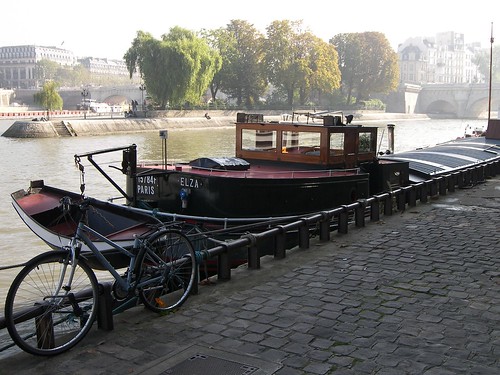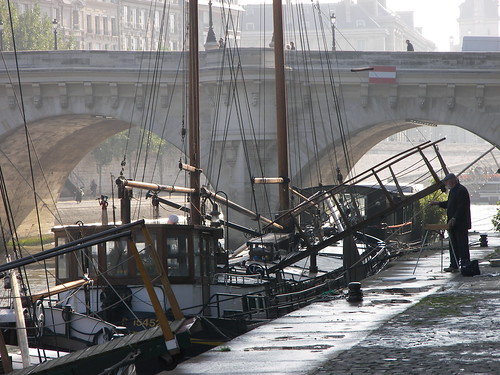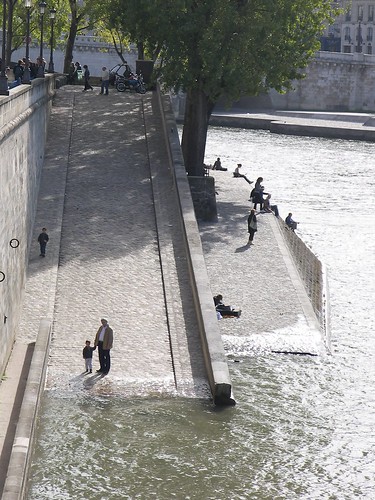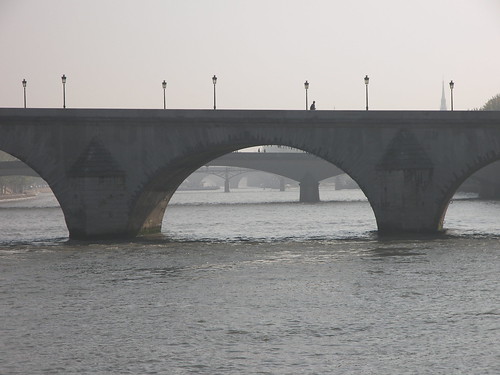|
StevoTrip2006 Friday, October 27, 2006
Stupidly Beautiful
On the last Monday of my trip I got myself a hire car and braved the nightmare of driving the L.A. Freeways in the frightening mirror-world of right-hand-side-driving, heading up to Yosemite National Park. The contrast between Yosemite and L.A. is, to understate astoundingly, quite something. The whole drive up to Yosemite, in fact, is exceedingly ugly: the intrusive billboards; the blighted, hazy plain outside Bakersfield; the treeless desert hills; and the crumbling, pock-marked freeways themselves. Even the farmland lacks the default prettiness that even the drabbest rural countryside usually has. Even up to the gate of the national park, where it gets hillier, is nothing special. It's as if Yosemite acts as some kind of scenic black hole, sucking all the natural grandeur out of central California and into the park. The centre of the park is Yosemite Valley. To give you an idea of what the valley is like, imagine that you took a crystal clear mountain stream: 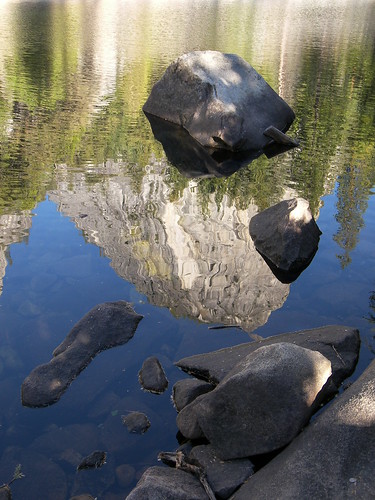 Let it meander through a through a pine forest... 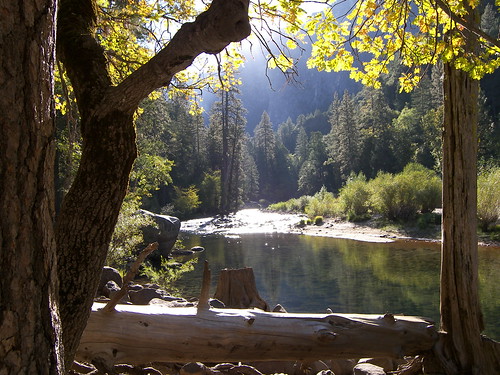 ...dotted with peaceful meadows... 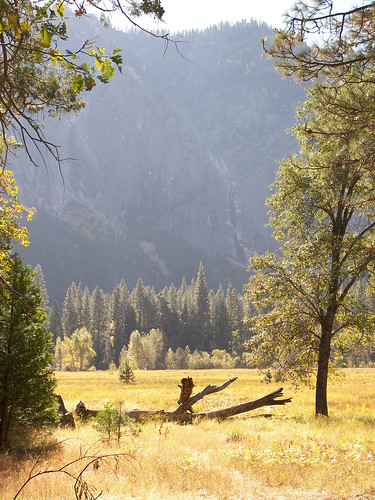 Punctuate the valley by adding a 3500 foot high granite monolith at one end... 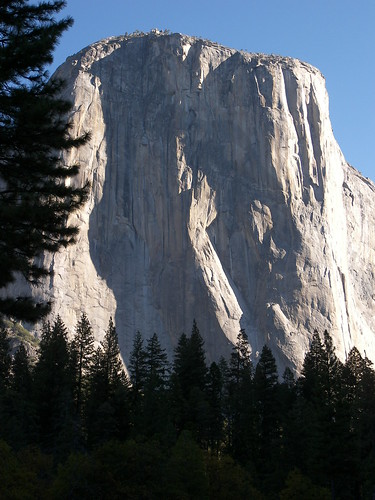 ... and a giant half-sphere of rock at the other. 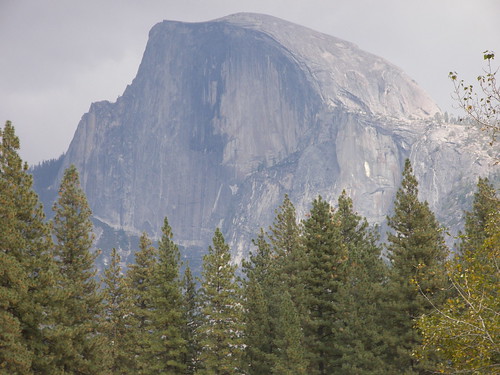 Fold the mountains up around the valley so that wherever you are you feel almost embraced by the rock: 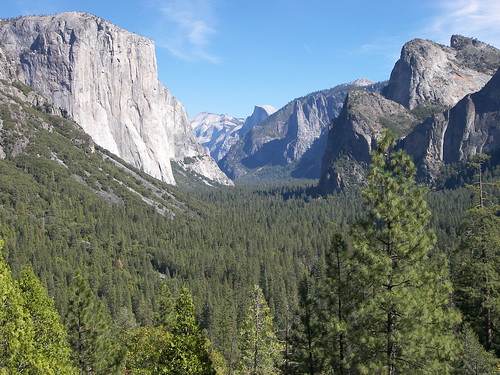 Then pepper each side of the valley with waterfalls. 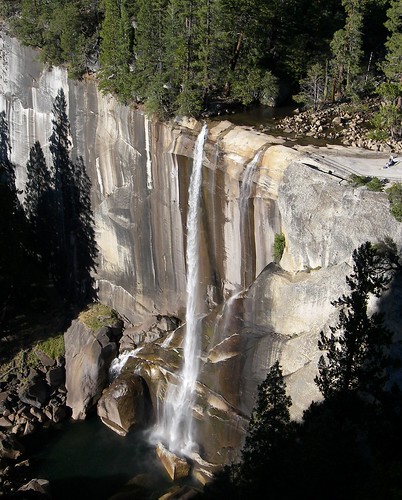 It's quite something. 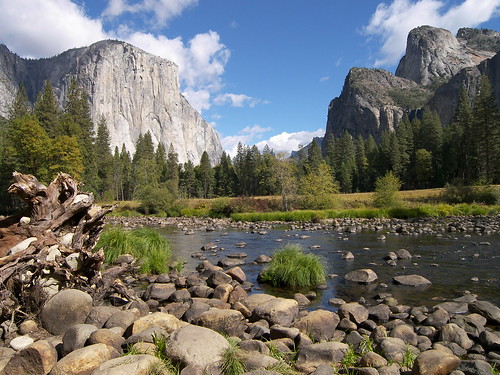 On the first day I went for a long (20km) hike along the valley floor. Yosemite has a reputation for crowds, but it wasn't very hard to get away from other people: despite its length, the trail I did was pretty accessible, yet I still only came across maybe a dozen other people walking it, and didn't see anyone else for as much as an hour at a time. That took me pretty much all day, but the views (such as that directly above) were well worth it. On the second day, I drove up to Glacier Point. This is a spot where you basically get a panoramic view of the whole valley, and in particular Half Dome. There are a few photos from there on Flickr, but for a slightly different perspective, here's a video give you an idea of what's before you as you stand at the point. On the way back I went to the Mariposa Grove, which is a grove of giant sequoia trees. They were doing a controlled burn at the time, which was a mixed blessing - parts of the grove were closed, but it also lent the grave an eery atmosphere that had a certain appeal. Amongst the trees in the grove is the Grizzly Giant, which is reputed to be up to 2700 years old. According the Wikipedia it is "only" the 27th largest tree (by volume) in the world. Who keeps track of these things? 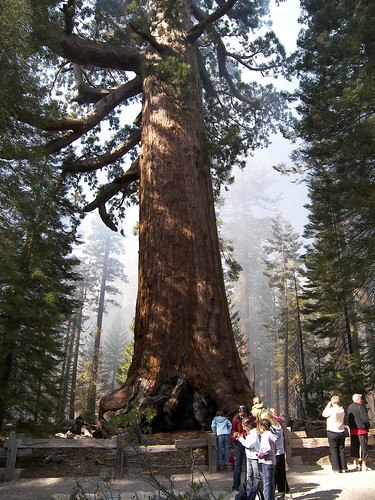 After my drive I returned to the valley and did the walk up to Vernal falls, which is at the top end of the valley (those are the falls in the photo earlier in the post). Most of the falls aren't at their best in October, and a lot have dried up completely - there are 9 major falls along the 20 miles or so of Yosemite Valley at the end of winter, but I only saw three (two from close, one from a distance). As you can see, they're still pretty spectacular; I can only boggle at the thought of how it must be earlier in the year. I would have liked to keep going up to the next falls (Nevada Falls) but time was against me: I continued up a bit further up and then cut back onto a different trail and descended as darkness approached. I definitely have to go back to Yosemite: I didn't have nearly long enough, and it's a place so beautiful even the squirrels stop to enjoy the view. 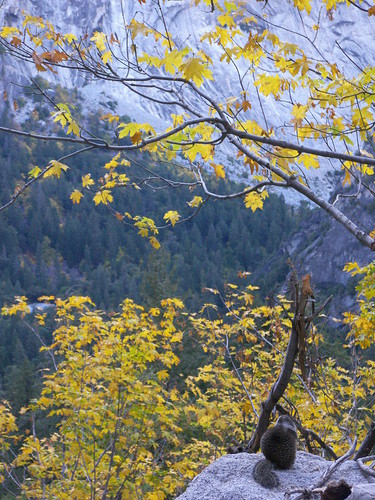 Wednesday, October 25, 2006
Exploring the LA Cultural Scene
After arriving in the US, I stayed from Wednesday evening to Monday morning with Margaret (a friend from my UCI days) and her boyfriend Chris in L.A.. Despite my longstanding disdain for L.A. as a city generally, it was a great few days thanks largely to the hospitality of Chris and Margaret. After I spent Thursday largely just recuperating after the flight in (Margaret had to work so I didn't have a car and couldn't really get anywhere anyway), we went to Venice Beach on Friday. Because it was a weekday there wasn't that much going on: but afterwards we went and visited Chris at his work, which was much more interesting. He's an assistant director on American Dad, so it was very cool for an animation nerd like myself to get a look around the studios where they make both American Dad and Family Guy (although I was slightly embarassed that I had seen basically nothing of either show). Seeing an actual working animation studio was an exciting first for me. On the Saturday afternoon we went to a barbecue with a lot of Chris' colleagues; this time there were ex-Disney people and at least one person who'll be working on the revived Futurama. It was a tough task not to overnerd. On Saturday night we really digged into LA culture when we went to roller derby. This was something I had assumed had died out many years ago, but no, it turns out there is a grassroots roller derby revivial going on. For those who have the image of roller derby as basically just organised brutality, the flyer they gave out at the track noted - somewhat defensively I thought - that: This is a REAL SPORT and there ARE rules.Fancy that. Wikipedia explains roughly how it works: While traditionally a sport for both women and men, roller derby has developed a predominantly female circuit during its current revival... Two teams of five skaters, wearing protective gear such as helmets, mouth guards, and pads, take up positions alongside each other in a pack formation. Each team consists of either four blockers and one jammer, or, rarely, three blockers, and two jammers... A signal is given and the jam commences... Initially leading the pack are special blockers known as pivots, who set the pace and give the other blockers direction in order to strategize and keep the pack relatively tight. Blockers who stray too far from the pack may not be allowed to engage opposing players. Blockers (including pivots) start skating at the referee's first signal. A second signal is given to launch the jammers, who must catch up to the rear of the pack. Jammers navigate through or around the pack, then lap around the track until reaching back of the pack again. The first jammer to get through the pack legally (for example, without cutting the track, going out of bounds, or acquiring any penalties) is dubbed lead jammer and may call off the jam at any time. Scoring commences when the jammers lap around the back of the pack and go through for a second time. One point is scored for each member of the opposing team passed by an inbound jammer (passing is determined by the skaters' hips). Blockers try to stop the opposing jammer from passing them, while defending their own jammer, whom they can assist by pushing or pulling (whipping) in an attempt to advance them through the pack. The jam concludes after a fixed period of time, usually 2 minutes, or when the lead jammer calls off the jam. Until then, both jammers are free to lap the pack again and again.... Physical contact between players is frequent and sometimes violent. Body blocking is allowed, and elbowing is allowed in some leagues, but participants are not allowed to trip or intentionally punch other players. Violence may leave the track and may include striking opponents with available objects... Well, it didn't leave the track in the derby we saw, but it constantly threatened to. The track had padded barriers around the edge, but there was a gap underneath it, and the crowd stood right behind that, so there seemed to me a fair possibility that players could get knocked off from the track and into the crowd. Certainly it's the only sport I've ever been to where every member of the crowd had to sign a (dubious) legal disclaimer in order to enter the track. Here, for the record, is one fairly typical "jam." This might appear very dark on some monitors - if you turn up the brightness enough you will be able to see something. I can't shake this image in my head of people in ancient Rome at the Colosseum reading little flyers saying "Gladiatorial Combat is a REAL SPORT and there ARE rules." Monday, October 23, 2006
Along the Seine
A couple of river views along the Seine to wrap up Paris: This is near the Ile de la Cite, with the square du Vert-Galant visible in the background. Just a little further up the river. The bridge in the background is the Pont Neuf, which means the "new bridge," although it is now the oldest remaining of the bridges in Paris. That is looking east from the bridge between the Ile de la Cite and the Ile St Louis. This is looking east along the Seine from near the Louvre. (The bridges are, in order from nearest to furthest, the Pont Royal, Pont du Carrousel, Pont des Arts, and the Pont Neuf, for anyone keeping track of such things).
No, I Didn't Go There Because of the Cartoon
I went To Notre Dame twice. Once was as part of my extended walking tour on the Sunday. At this point they were performing mass, which made for a most uncomfortable experience. They don't close the church to tourists when the ceremony is being performed, and the tourists were wandering around, talking, taking flash pictures (which you're not supposed to), climbing on the pillars to see areas that were out of view, and so on. I felt so uncomfortable being there that I rushed through and didn't really appreciate it properly, so I came back on the morning I left had another look. The second time was a little better, and I got to appreciate the place a bit more. It certainly is as beautiful as its reputation suggests: not overwhelmingly grand like some other cathedrals I've been too, but intricate, very well designed (the inside has very dramatic proportions that give it a really strongly vertical feel) with particularly impressive stained glass. I also very much liked its very extravagant flying buttresses at the back. 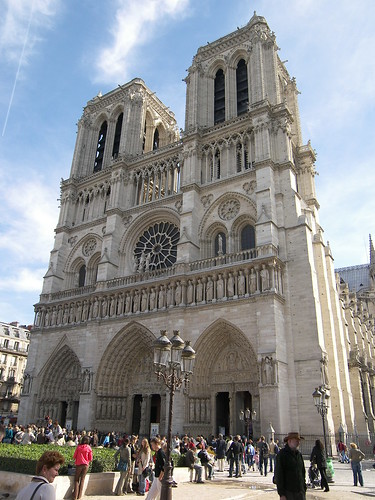 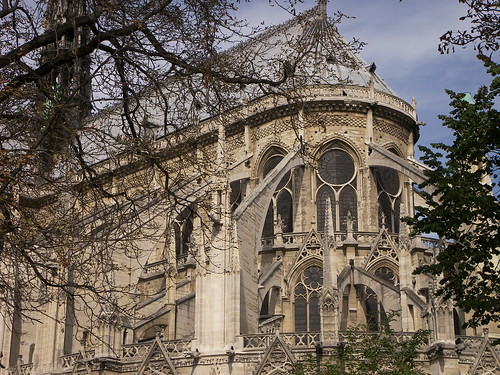
Le Arche de Ridiculousle Grande
On the Monday in Paris, after going to the Disney exhibition, I headed out to La Defense. This is basically the corporate bit of of Paris, and is the most un-Parislike bit of the city I went to. Instead of the four and five storey buildings orderly arranged along interconnecting boulevards that define the centre of Paris, La Defense is the best of the twentieth century: various randomly placed, diversely sized and haphazardly designed builings scattered along each side of the axis that extends all the way down to the Louvre (via the Arc De Triomphe). That is the reason I was out there: the Grand Arch De La Defense (roughly translated: "The Grand Arch of Defense.") It's a crazily huge arch that terminates the other end of the Louvre / Champs Elysees / Arc De Triomphe vista. The Arch itself houses offcie buildings (can't have a grand civic gesture that doesn't pay the rent) and they say that Notre Dame would fit under the arch - which is the kind of thing that's always good to know, in case you ever need to put it there. 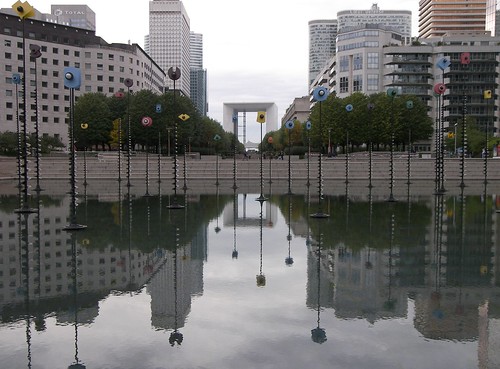 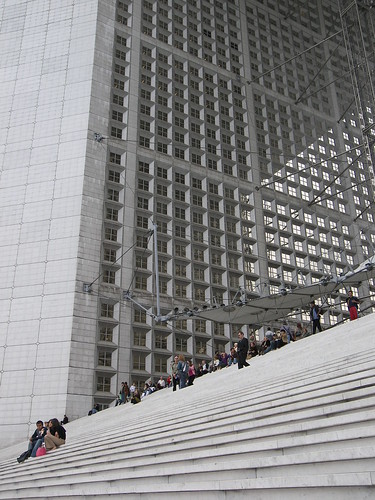
Louvre At First Sight
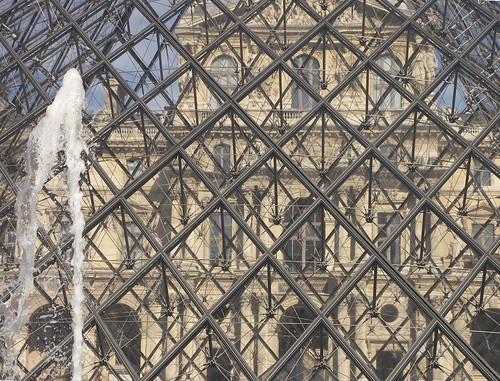 As mentioned, on the Sunday afternoon in Paris I went for a quick tour to the Louvre. I didn't quite dash in and out in the way you might have gathered from my hectic itinerary that day: I spent a few hours there. But in a place as vast as the Louvre, that is a pretty quick visit. Basically, I did a fairly speedy survey of the rooms that chronoligically covered the history of French art, and then ducked over to the Italian area to see this old thing (or rather, see the crowds seeing this old thing):  What I discovered at the Louvre is that basically I'm a philistine. You may have already worked this out, but exposing myself to the world's finest art collection really rammed it home. It's not that I didn't enjoy it: it's all good stuff. But I just can't get as excited about great art and sculpture as I know I should. I mean, with the Mona Lisa, I agree that Leonardo managed a great enigmatic smile on that thing. An exceptionally good enigmatic smile even. But given the Mona Lisa is apparently valued for insurance prupsoes in the order of $650 million dollars - well, it's not that good a smile. I'll freely admit this is my own ignorance showing. Basically, I just don't know enoguh about these things to really appreciate the importance, the significance, and the context of what I'm seeing. That's why I get much more excited about the architecture of the Louvre itself: I know a little more about that side of things. Having seen I.M. Pei's famous (and formerly controversial) pyramid, I can confirm I like it. (Much to the relief of the French I'm sure). Call me dense though - I'd never realised that it isn't actually attached to the original Louvre buildings. This makes the "But they added a pyramid to the Louvre" argument that has been the catch-all rationalisation for ghastly additions to heritage buildings since 1989 therefore seem even more tenuous. If I can dwell a little more on the way knowledge and ignorance has shaped my artistic priorities, the next day I went to the Grand Palais to see an exhibition of artwork from the Disney studios that happened to be in town. As far as I can establish, this has been the largest public display of material from the Disney arhcives ever. They had a lot of the concept and desing drawings by people like Mary Blair, Eyvind Earle, Albert Hurter, and Joe Grant, as well as background drawings and - best of all - original animation drawings, including some of Ub Iwerks stuff for the earliest Mickey Mouse shorts and some of Bill Tytla's original drawings of Chernobog for the Night on Bald Mountain sequence in Fantasia. They even had some stuff that might have impressed people interested in proper art, most notably Salvador Dali's drawings for Destino, the short that Disney and Dali started work on in 1945, and which wasn't completed until 2003. Because I actually know about this stuff, it meant a lot more to me, and I got a real buzz out of seeing the Tytla drawings in particular. Tytla was the best animator at the Disney studio at the time when it was producing the finest animation that has ever been produced, and if the art of animation has had a Leonardo da Vinci it's Tytla. And if he has a Mona Lisa, it's the Chernobog sequence, which is often cited as the best bit of animation ever done. So this is why I got such a thrill out of seeing it, and why for me at least it meant more than seeing the really important stuff the before at the Louvre.  As I said, I'm such a philistine.
Friday, October 20, 2006
Eiffel Tour
I went past and around the Eiffel Tower a few times before I went up it. As I mentioned before, it was near my hotel, and it was an easy detour on the way to various things, notably the Arc De Triomphe and the Champs Elysees. So on both the Saturday I arrived, and on Sunday, I had a good walk around the base of it. But the queues were crazy, and so I saved my proper visit until the Monday, and spent most of a morning there. It gets more and more spectacular as you get closer: not so much just because its size becomes more apparent - though there is that - but because it looks less and less like the picture-postcard image. From near to underneath you can start to make out the incredible detail of the structure, and once you're under it the shape becomes really interesting, with lots of unusual angles and interesting new perspectives on its symmetries. And of course it's unusual in that it's such a tall structure that you can get under and within, and still see: like a transparent Empire State Building. 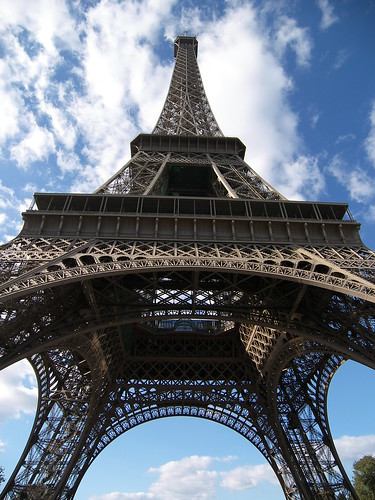 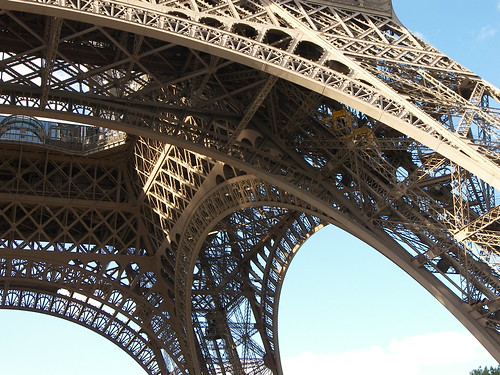 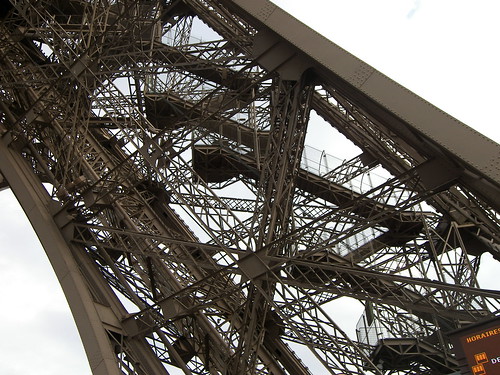 I went up via the lift and came down via the stairs (which take you up and down from the second of its three levels - only the lift goes to the top). This might sound silly, but once you start going up it, it really surprises you how big it is. When it was built it was the tallest building in the world, and it's very hard to believe that it was originally constructed as a temporary structure. The best way to convey what I'm talking about is to show you the lift ride up. Here's ground to level 1: I missed level 1 to 2 (I was expecting to have to change lift, so it caught me by suprise) but here's level 2 to the top. This really gives you a sense of how unexpectedly high it is: Once up there, the views of Paris is everything you'd expect - the central / historic area of Paris is otherwise free of high buildings (the nearest are at La Defense, at the far end of the Champs Elysees axis) so it really towers over everything. However, I still found myself most taken with the structure itself. 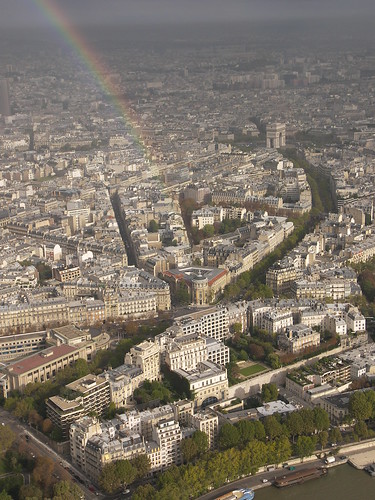 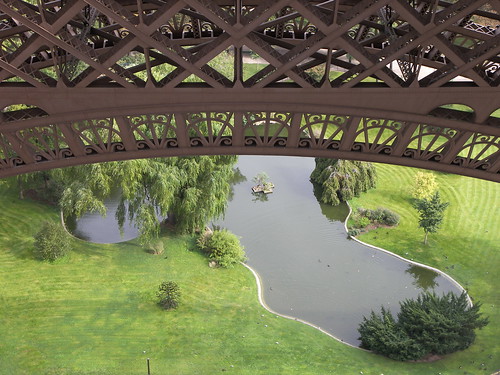 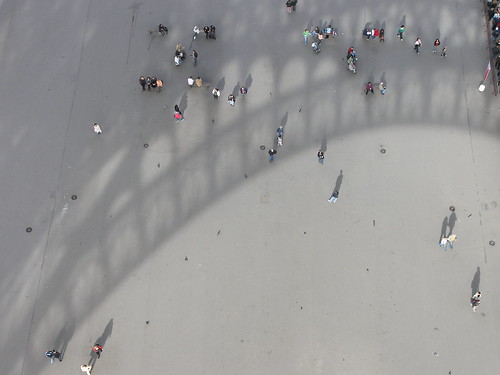 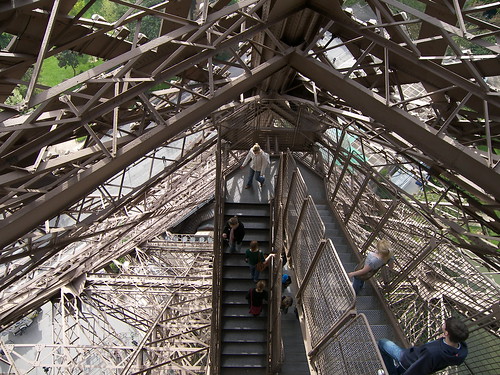 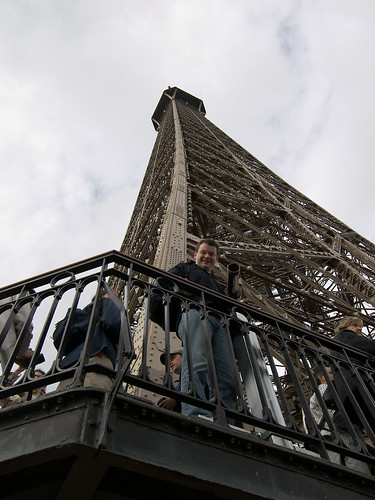 I'd like to thank the nice man who took the photo above for not stealing my camera. Saturday, October 14, 2006
A Day in the Life of Paris
After very briefly returning to London, my next stop was Paris, where I was from Saturday to Tuesday last week. It's hard to know where to start with Paris, because the whole place was so amazing and because I did so much in the few days I was there. So to warm up for a more detailed account of the highlights, I thought I might just post a few slice-of-life videos, once again hosted by the good people at the dubiously named DailyMotion. I realise some of you probably can't open these, but they do give a good feel for the place. That said, don't expect anything mind blowing in these. They're just example of what it's like to walk around on the streets. All are from the Sunday, my first full day in Paris. Place Dauphine This is mid-morning, when I went on a walk from my hotel near the Eiffel Tower, across to Notre Dame and the two Islands (Ile-de-la-Cite and Ile St-Louis) that are at the heart of old Paris. Place Dauphine is a small square at the western end of the former island, but despite its centrality is probably the most peaceful place I found in Paris. I did the classic Parisian thing and had a coffee on the table out the front of a cafe facing the square.  Mmmm... pretentious... Pont St-Louis This is maybe a bit after noon, after I had been to Notre Dame. This view is of the rear of Notre-Dame, and then pans across to the Pont St-Louis, the small bridge that links the two islands. View from the Arc De Triomphe A brief view of the insane traffic around the Arc de Triomphe, late-ish on Sunday afternoon. If I had been more persistent I could have gotten a much better example of how bad it is than this, but this should serve as a reasonable demonstration. Tim later explained to me the road rule at play here: traffic already on the roundabout has to give way to traffic entering it. Madness. Parc Du Champ de Mars This is the park in which the Eiffel Tower stands. This was in the afternoon afternoon, maybe about five o'clock, as I came back to my hotel. Given I also went to the Louvre this day, I'm a little surprised that I managed this all in one day. No wonder I slept so well in Paris. Friday, October 13, 2006
Chobham
This one's probably not really of interest to anyone outside my family - but then, that's possibly applicable to this whole exercise. The other thing I did while I was at Brighton was take a day trip over to Chobham, which was where my family lived when in England. I spent a fascinating afternoon looking around places I only vaguely remember, but have seen in many photos and home movies. Here's the ford:  By way of comparison, the same spot in the late 1970s:  And I thought my family would get a kick out of this, given the role my brothers played in dragging the canon through the streets.   Thursday, October 12, 2006
I Do Like to Be Beside the Seaside
The last two nights of my southern sojourn were spent in Brighton. I had come to Brighton because Tim, Rebecca and I were seeing The Goodies' live show, which was on at the Brighton Dome. It was actually very enjoyable: I think we had all feared the worst, what with the age of the participants, the fact that Bill Oddie wasn't even turning up (although he did feature in prerecorded video segments) and, let's face it, the unevenness of the Goodies even in their heyday. It was quite sparsely attended though, with people only speckled through what was quite a large venue. They did make one slightly bitter crack suggesting that the show hadn't been properly advertised, although there is always the fact that they seem to have been largely forgotten in the UK (in contrast to the ABC, the BBC never repeated their TV show). Brighton itself is a very nice town, with lots of restaurants and pubs. The chief actual sight is the Royal Pavilion, which was decked out in the early 19th century by the Prince Regent / King George IV. If I can reduce actual real world history to the level of television comedy for a moment, this is the George from the third series of Blackadder, and I can imagine that the characterisation from that show would have been largely inspired by this building. Basically, it's quite obscenely extravagant and over-embellished. It's a massive demonstration that if you spend enough money, you can turn even the worst taste into an architectural marvel. The other major landmark is the Brighton Pier. I almost didn't make it down the pier because the weather on the morning I was planning to go down was so feral. Fortunately, however, the rain stopped for just long enough for me to experience the true British seaside resort experience. I suppose it's my own silly fault if I will insist on going in October.
Worrying Signs
A couple of signs that worried me. The first is a roadsign that's everywhere in Britain:  It sort of makes sense in little villages with single track roads (which is where I took this). In Scotland, however, they'd post this apparently at random along the side of what were quite major (by Scottish standards) double-track roads, apparently just to freak you out. It certainly kept me on my toes. And then there was this:  And please could you stop doing your laundry in the septic tank?
Stonehenge With a Farm In It
I'll try to just very quickly cover the week I spent down in the south of England, commenting on a couple of highlights. This is partly because I'm way behind and want to get to the more interesting stuff (ie Paris), and partly because I didn't see as much as I'd hoped. A combination of poor planning, a couple of days where I was feeling under the weather, underestimated travel times, and other factors meant that I didn't see as much as I'd hoped in this part of the world. Bath got dropped completely, for example, and the Cotswolds became a lightning tour (basically an afternoon spent wandering around Chipping Campden - a town about which there is little to say other than to note that it is indeed delightful). There are also a couple of places, like the Brighton Pavilion, for which I have no multimedia to share because they didn't allow photos. One thing I did get to have a good look around was Avebury. I was in the general vicinity of Stonehenge, but had heard so many things about how disappointing and unatmospheric Stonehenge was, I instead went to Avebury, which is the next most significant ancient monument in Britain, and is quite nearby. Basically it's a huge complex of rocks, arranged in several circles with a giant ditch and embankment as well. Like Stonehenge, nobody has a terribly good idea of who built it or why. What's really odd about Avebury is that over time the locals have just worked aorund the stones, to the extent that there are farmhouses and a tiny little village right in the centre of the circle. Sheep graze around the stones themselves. Very strange, and in contrast to what I hear about Stonehenge (which is right next to a freeway) very pastoral and relaxing to walk around.    Tuesday, October 10, 2006
Lego London
I can imagine a few people might be a bit disappointed that my account of London didn't focus on the more traditional sights. Well, fortunately Legoland Windsor came through for you all. Tim and I were both a bit worried that Legoland might be a bit of a disaster. After all, we are adults - really - and we were trekking halfway across London to visit a children's theme park. In the end, however, it was very worthwhile. We spent most of our time in the bit the kids rush through: the large-scale Lego models of various European cities. And of these, undoubtedly the best was the newly completed model of London. It was very impressive for its detail, the innovative building techniques, and its scale. So, like it or not, here are some highlights.  Surveying London  Trafalgar Square  Trafalgar Square Detail  Big Ben  Docklands (With Working Docklands Light Rail)  London Streetscape (Covent Garden maybe?)  St Pauls Cathedral (My Favourite) To give you an idea of the detail on these models, they had working cars that drove around (without tracks). And there were a lot of clever little touches when you looked closely, like this appearance by Lou and Andy from Little Britain, plus the Tardis and K-9 from Dr Who.  So yes, I enjoyed Legoland. Thanks for asking.
But Why Doesn't it Look Like Kirsten Dunst?
Speaking of toys, Tim and Rebecca thoughtfully remembered my birthday, and had this for me on my return to London.  The reverse is actually better yet, offering her "Special Ability" as "Cleavage." (An element of the toy that this photo doesn't really do justice). The chief liability of Marie as an action figure is the difficulty in keeping her "ejector head" attached to the body - a shortcoming, of course, shared by the real historical figure.
Saturday, October 07, 2006
London Round Up
Well, that gets me back to London. I spent the week between the 26th and the 2nd at Tim and Rebecca's place in Clapham Junction. It's been great catching up with them. I caught up with a lot of the headline London sites back in 2002, so during the day, when Tim and Rebecca were at work, I concentrated on a few gaps in my coverage and just generally looking around. Highlights: The RAF Museum Not quite the Air and Space Museum, but still worth doing. As you might expect, they have a great collection of the Battle of Britain era planes: several different varieties of Spitfires, some Me109s, and some Hurricanes. I can't rationally defend liking these planes so much - instruments of war and all that - but the plane nerd in me laps it up. Though I think you can make the case that the Spitfire is, divorced from its role, a classic bit of design. What with its sleek lines and elliptical curves, it looks like a Good Guy Plane:  Meanwhile, the main German fighter from the Battle of Britain is aggressive, muscular, and mean-looking. A classic Bad Guy Plane:  Churchill War Rooms / Churchill Museum These are the bunkers where Churchill and the war cabinet hung out in World War II (although Winston apparently had a habit of going AWOL and puffing his cigars on top of exposed buildings during the blitz - a perfect example of the combination of solidarity with the people and cantankerous insanity in which he seemed to specialise). The key rooms themselves are hardly changed: some had been restored from photographic records, others were apparently just left pretty much undisturbed after the war. One area houses the recently opened Churchill Museum. As a brand new museum, it was the most high tech I'd seen. Often museums do the whole "interactive" exhibit thing pretty badly. You know what I mean: press a button, box lights up, voiceover starts, person who pressed button walks away leaving "interactive" exhibit talking to nobody... and that's if the button works. However, this place did this kind of thing about as well as I've ever seen it done. Firstly the subject is suited to it, as they could build things around all those great speeches he did (so many to so few, fight them on the beaches, etc). They also had a display that was like an enormous table with interactive video screens built into the top of it, laying out all the years of Churchill's life. Touch a year and the calendar opened up to show you all the months, and then you could drill down further. For key parts of his life (eg both World Wars) you could get a virtually day by day breakdown of what Churchill was up to. Very well done. Regent's Park One of the classic bits of London planning. I did an assignment on this at uni and learnt all about it, although it didn't mean that much not having been there. So I went and saw it, but could only remember the broad outlines of what I'd studied at uni. So now I'll go back home, read the assignment, and put it all back together in my mind. British Museum I'd been here before, but I thought I'd go back again. But I came away underwhelmed. Yes, it's one of the great collection of artifacts and antiquities in the world. But they just don't present it well. It's very hard to get much sense of what the stuff is: they don't do a very good job of bringing it alive or making it clear why it's important. It's just case after case of loot, really. Although it was good to see the Rosetta Stone again, which for some reason I just find very cool, and I just love the main central courtyard around the reading room (which for years was roofed and used for storage, but was opened up again around the millennium). It's a great bit of design and just an amazing space:  Grand Final The result wasn't what I wanted (I thought if Sydney won the AFL and the Storm won the NRL, maybe the states could organise some sort of swap), but what better place to see the AFL grand final than a London pub? We got up for a hellishly early start (4:15 - the game started at 5am in London) and made our way to the Oktoberfest Hotel. We thought this might be pretty dodgy, an impression not helped by the fact that unlike many places this was free entry, and the ad promised "AFL Grand Final 5am; Jelly Wrestling 6pm." But it was actually a good place and pof course the game was very exciting. I can't necessarily vouch for "the Fest" when the jelly wrestling is on, but it was fine for the Grand Final. And a very exciting game, obviously. West End Musicals Tim, Rebecca and I also did manage to fit in a West End show. We chose one from the cheaper end of the spectrum, Avenue Q, which is basically a bit of a take on Sesame Street, with puppets singing songs that play against the expectations of Sesame Street. So, for example, instead of typically affirming Sesame Street style message song, they had a song called "Everyone's a Little Bit Racist." Apparently it won the Tony (Avenue Q, not "Everyone's a Little Bit Racist"). Streets of London One of he best things about London is just being on the streets though, as the whole place has such a big city buzz about it. And you come across unexpected things like this:  Although the actual highlight of London was the trip Tim and I took to Legoland. I'll write about that in my next post. For the moment, I'll let one image allow you to gauge my enjoyment of it.  |
Because a holiday doesn't actually happen if you don't spend it in internet cafes describing it to other people. www.flickr.com
This is a Flickr badge showing photos in a set called Paris, 2006. Make your own badge here.
Stupidly Beautiful Exploring the LA Cultural Scene Along the Seine No, I Didn't Go There Because of the Cartoon Le Arche de Ridiculousle Grande Louvre At First Sight Eiffel Tour A Day in the Life of Paris Chobham |
